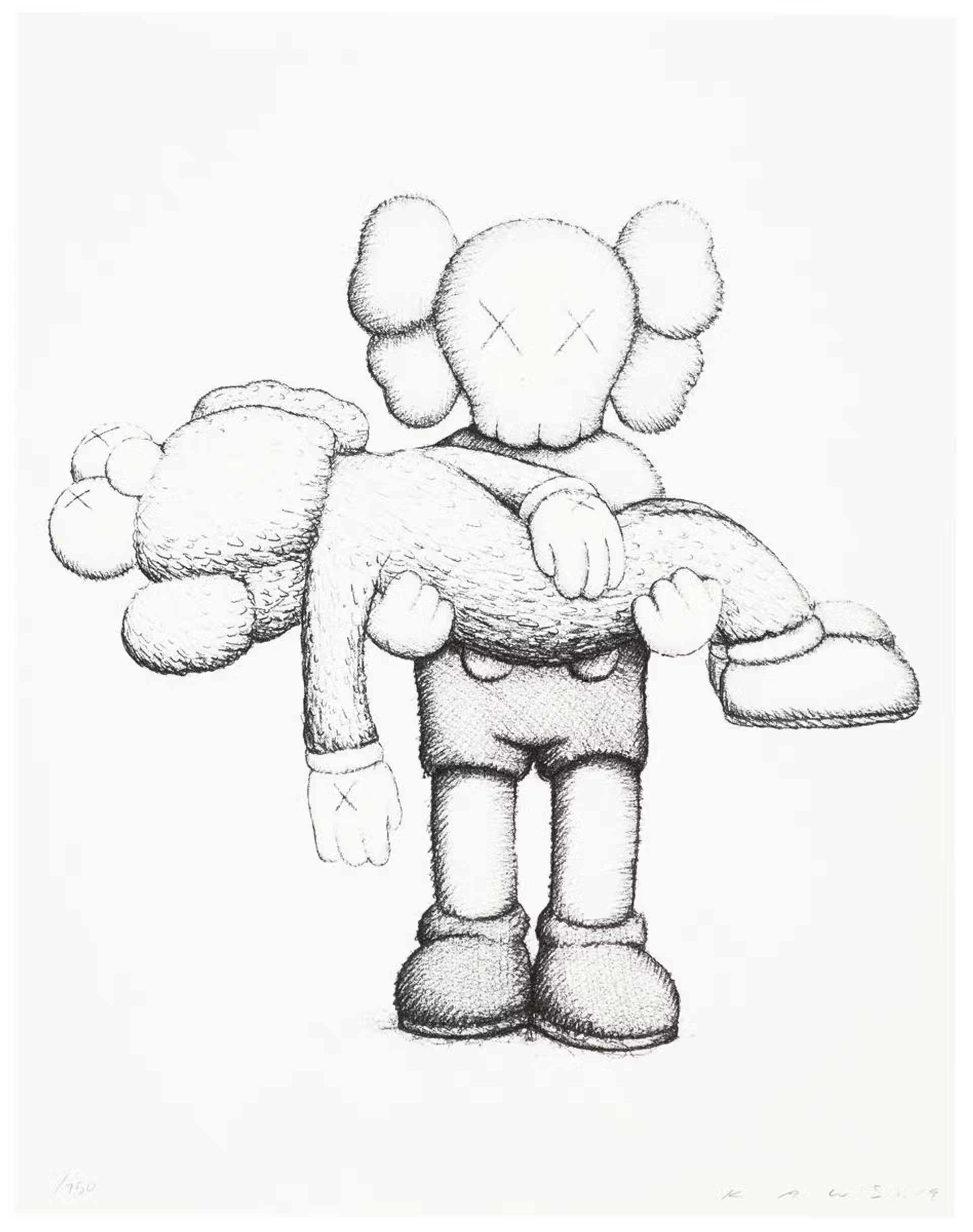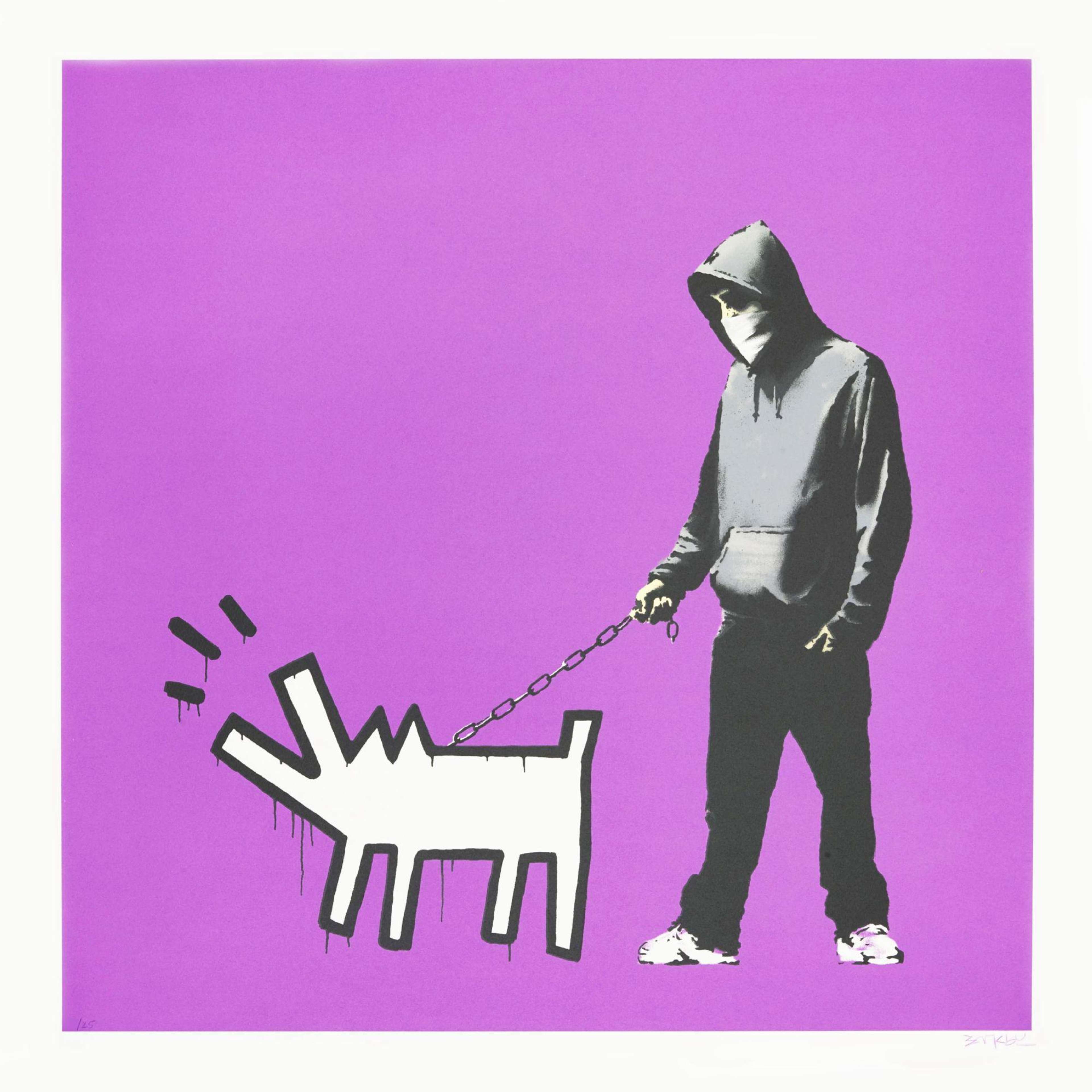 Chum VS Astro Boy © KAWS 2002
Chum VS Astro Boy © KAWS 2002
KAWS
119 works
With over 3 million followers on Instagram and KAWS' work selling for as little as $50 at Uniqlo last year and as much as $14 million at auction, he's proving to be one of the most successful artists of the 21st century.
From the catwalk to the gallery, his work is gaining popularity around the world among collectors, critics and kids alike. With his prices set to rise even higher, now is the time to invest in the artist’s striking artworks that blur the boundary between high and low art, demonstrating his mastery at navigating social media and pop culture, as well as the world of fine art.
Prints
Multiples are by far the most collectable of the KAWS oeuvre, and offer a range of works to become familiar with, as well as a broad spectrum of value. Edition sizes of KAWS prints range from 20 to 250. The characteristic quality of KAWS’s work in this medium and the tremendous demand for them keeps the market moving. Complete sets of 10 screenprints are highly requested by collectors. Most popular are Ups & Downs (2013), Blame Game (2014), No Reply (2015).
To discuss your KAWS print or collection, do not hesitate to speak to our specialist brokers whose wealth of knowledge in the market can help navigate this vast and growing category for KAWS.
Paintings
KAWS’ turned to painting more prolifically in the early to mid-2000s, and his paintings are in very high demand. His earliest works featured distorted images of familiar animated characters including the Smurfs, the Simpsons and SpongeBob SquarePants.
Whilst the medium of painting places KAWS work in the fine art category, his work further blurs the lines between high art and popular culture. As the Museum Curator, Michael Auping, wrote: “KAWS is [art critic Clement] Greenberg’s worst nightmare and a philosophical challenge to those of us who, perhaps secretly, want to believe in fine art ‘purity’ and the separation between high and low.”
Sculptures
KAWS' sculptures (aside from toys, and excluding his monumental installations) have been produced in editions of 10, 25, and 100. Monumental sculptures, meanwhile, come in editions of two or three.
The first of such was a Companion sculpture created for his then Tokyo boutique, OriginalFake, which opened in 2006 and closed its doors in 2013. Work from KAWS’ OriginalFake period are – rather ironically – the most subjected to being faked, and hence it is in this area that authentication is absolutely vital. As with all editions, paper trails are important. Selling through on a reputable and reliable platform ensures you know you’re getting a fair price for your KAWS work, and buying via one allows absolute trust in what you’re getting for your money. MyArtBroker’s specialist brokers can help advise you on all counts.
Toys
KAWS has created in excess of 100 editions of his most famous characters. Among them is Companion, KAW’s ubiquitous Mickey Mouse- inspired cartoon with Xs for eyes, for most fans Companion has icon status as the symbol of today’s popular culture. There is also Chum, a version of Companion that is reminiscent of the Michelin Man, and Accomplice, another seeming relative of Companion, but with a pair of rabbit ears. These are produced in vinyl, wood, and mixed media.
KAWS released his own toy figures from his website in 2002, rather than via collaborators, as he had in the past. At that time they were priced at $100 and $500. As with all artists who produce editions, multiples helpfully present collectors with an opportunity to collect at various budget levels. As always smaller and larger edition sizes place work more or less in demand, and value is most often dictated by demand.
Collecting Editions
Prints enrich any collection, showing another side to a beloved artist’s work or allowing newer collectors to acquire authentic and iconic works at a lower price point. The formal qualities of a screen print or lithograph versus an oil on canvas can be fascinatingly diverse, allowing the artist to experiment in ways that are not possible with an original.
What to look for in a KAWS print
As when buying any work of art, authenticity and provenance are key. Most KAWS editions are signed by the artist so this should be the first thing to look for. Secondly the condition must be pristine – the print should have been kept away from direct sunlight and moisture and remain untrimmed. Edition size is important, but it is not necessarily important to the value of an investment. Finally, provenance is everything – always ensure the print you are buying is accompanied by the relevant paperwork: a certificate of authentication, gallery or auction receipts, or even documents detailing previous owners, to ensure that the piece does not lose value. Speak to one of our specialist brokers if you are considering purchasing a specific work of art for free advice.
 No Reply (complete set) © KAWS 2015
No Reply (complete set) © KAWS 2015What To Spend
Expect to spend anywhere from $1000 to $50,000 on a KAWS print. Naturally portfolios of multiple prints will fit into the higher range while single prints can be purchased for a lot less.
Although KAWS first made his name in the early 2000s it was only more recently that his work has been truly excelling in terms of value. According to the 2019 Artnet Intelligence Report, in 2017 his average sale price almost doubled, from $42,272 to $82,063, while this year saw him achieve his highest result yet with £14.8 million paid for his work The Kaws Album, a witty homage to both the Simpsons and the Beatles. All this adds up to a very healthy secondary market report for KAWS. If you have any questions about buying and selling KAWS prints, please do not hesitate to get in touch, we would be happy to advise you on the next step towards owning your first or next KAWS work of art.
The KAWS Effect – Loved and Loathed
Some – not many – are immune to the KAWS effect, in fact some critics have denounced him, ruling him out as a key figure in the art world, or certainly not someone that will go down in history. Josh Baer, the art advisor and publicist once said: “I don’t think that the history of art will go: Matisse, Pollock, Johns, Basquiat, KAWS. If you think that Paris Hilton and the Kardashians are important cultural figures, then you’re likely to think KAWS is an important artist.” Meanwhile, over 1.1 million photos have been tagged on Instagram with the hashtag KAWS, whilst the closest second in Baer’s revered history of art list is Basquiat, with a comparably quiet 671,000 hashtags.
So, is the sheer power of KAWS’ reach the main facilitator of his remarkable popularity? Or is there something in his work that allows it to sit comfortably alongside the work of pop culture icons Andy Warhol and Keith Haring? Alberto Mugrabi, whose family owns the world’s largest collection of Andy Warhol seems rather convinced. Describing his first encounter with KAWS – who’s work he now avidly collects – he explains, “This was like some sort of street art that I hadn’t seen before that came out of Keith Haring and all the graffiti artists…It looked familiar but completely unfamiliar. I understood that this guy had a completely different type of language.”
It was perhaps when dealer Per Skarstedt, who represents the likes of Georg Baselitz and Martin Kippenberge began representing KAWS in 2018 it was as if the brakes had been taken off, any residual concerns the world’s contemporary collectors had around the validity of KAWS seems to have completely evaporated. Popular culture iconography has always been KAWS inspiration but his characters are fast becoming cultural icons in their own right. His distinctive style bends the rules and blurs the boundaries between reproduction, originality, illustration, advertising and fine art. For now, at least, the market’s appetite for KAWS is veracious.












